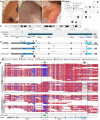This is a preprint.
Long-Read Sequencing is Required for Precision Diagnosis of Incontinentia Pigmenti
- PMID: 39975911
- PMCID: PMC11838753
- DOI: 10.21203/rs.3.rs-5811417/v1
Long-Read Sequencing is Required for Precision Diagnosis of Incontinentia Pigmenti
Update in
-
Long-read sequencing is required for precision diagnosis of incontinentia pigmenti.HGG Adv. 2025 Jul 10;6(3):100468. doi: 10.1016/j.xhgg.2025.100468. Epub 2025 Jun 12. HGG Adv. 2025. PMID: 40515401 Free PMC article.
Abstract
Incontinentia pigmenti (IP) is caused by loss-of-function variants in IKBKG, with molecular genetic diagnosis complicated by a pseudogene. We describe seven individuals from three families with IP but negative clinical testing in whom long-read sequencing identified causal variants. Concurrent methylation analysis explained disease severity in one individual who died from neurologic complications, identified a mosaic variant in an individual with an atypical presentation, and confirmed skewed X-chromosome inactivation in an XXY individual.
Conflict of interest statement
Additional Declarations: Yes there is potential Competing Interest. MHW has consulted for Illumina and Sano and received speaking honoraria from Illumina, Sano, and GeneDx. DEM is engaged in a research agreement with Oxford Nanopore Technologies (ONT), is on a scientic advisory board at ONT and Basis Genetics, has received travel support from ONT and Pacic Biosciences, and holds stock options in MyOme and Basis Genetics. Individuals from Family 1 were enrolled in the Manton Center for Orphan Disease Research, under a protocol approved by the Boston Children’s Hospital IRB. Individuals from Family 2 were recruited using a protocol approved by the University of Washington IRB: protocol 7064 (University of Washington, Repository for Mendelian Disorders). Individuals from Family 3 were recruited using a protocol approved by the University of Washington IRB: protocol 20161 (University of Washington, Genomic Discovery Initiative). All participants or their legal guardian provided written consent.
Figures


References
-
- Aradhya S. et al. A recurrent deletion in the ubiquitously expressed NEMO (IKK-γ) gene accounts for the vast majority of incontinentia pigmenti mutations. Hum. Mol. Genet. 10, 2171–2179 (2001). - PubMed
-
- Frans G. et al. Conventional and Single-Molecule Targeted Sequencing Method for Specific Variant Detection in IKBKG while Bypassing the IKBKGP1 Pseudogene. J. Mol. Diagn. 20, 195–202 (2018). - PubMed
Publication types
Grants and funding
LinkOut - more resources
Full Text Sources
Miscellaneous

